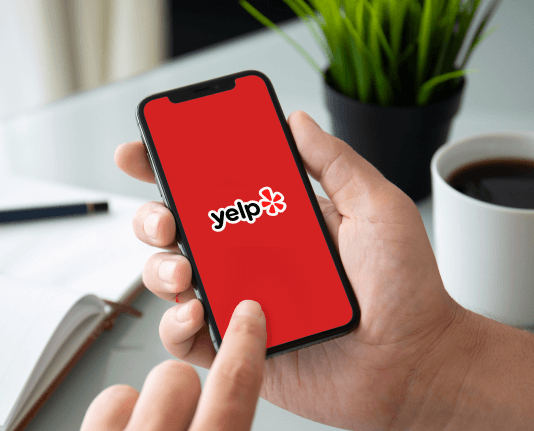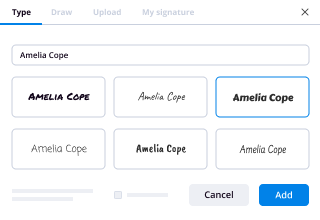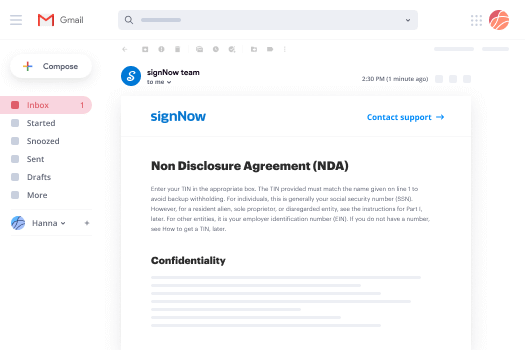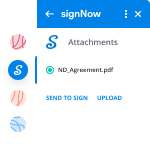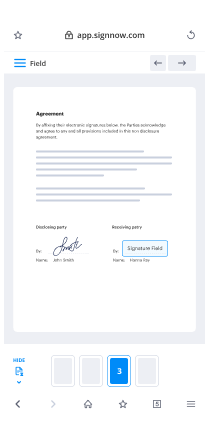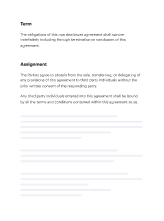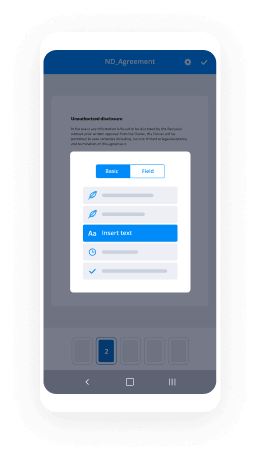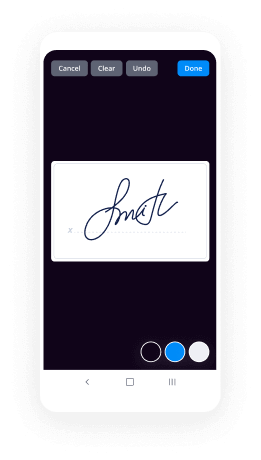How To Set Up eSign in CRM
Contact Sales
Make the most out of your eSignature workflows with airSlate SignNow
Extensive suite of eSignature tools
Robust integration and API capabilities
Advanced security and compliance
Various collaboration tools
Enjoyable and stress-free signing experience
Extensive support
Keep your eSignature workflows on track
Our user reviews speak for themselves






Guide to Configure eSign in CRM
Configuring eSign within your CRM can signNowly improve your document handling process, rendering it smooth and effective. With airSlate SignNow, you can effortlessly dispatch and sign documents electronically, facilitating quicker transactions and optimized workflows. Let’s delve into the steps to configure eSign in CRM utilizing airSlate SignNow.
Steps to Set Up eSign in CRM
- Launch your web browser and go to the airSlate SignNow site.
- Register for a free trial or log in to your current account.
- Select the document you want to sign or send for signing and upload it.
- If you intend to utilize this document regularly, transform it into a reusable template.
- Access your uploaded document and perform necessary modifications, such as adding fillable fields or inserting specific data.
- Affix your signature and designate signature fields for the recipients.
- Press 'Continue' to set up and send out the eSignature invitation.
With airSlate SignNow, enterprises can utilize a powerful eSignature solution that is not just user-friendly but also cost-effective. It provides an extensive range of features that yield substantial return on investment, making it an excellent option for small to medium-sized enterprises.
In summary, adopting airSlate SignNow for eSigning within your CRM can enhance your procedures and conserve precious time. Begin your free trial today and witness the advantages of effective document management with airSlate SignNow!
How it works
Rate your experience
-
Best ROI. Our customers achieve an average 7x ROI within the first six months.
-
Scales with your use cases. From SMBs to mid-market, airSlate SignNow delivers results for businesses of all sizes.
-
Intuitive UI and API. Sign and send documents from your apps in minutes.
A smarter way to work: —how to industry sign banking integrate
FAQs
-
What is the first step on how to set up eSign in CRM?
To begin, you need to integrate airSlate SignNow with your CRM system. This typically involves accessing your CRM's settings and selecting the option to add a new integration. By following the prompts, you can connect airSlate SignNow, allowing you to streamline your document signing process.
-
How does airSlate SignNow enhance my CRM's eSigning capabilities?
airSlate SignNow enhances your CRM's eSigning capabilities by providing a seamless interface for sending documents for signature directly from your CRM. With its user-friendly features, you can track the signing process and ensure that all documents are signed promptly. This integration not only saves time but also improves your overall workflow.
-
What pricing plans are available for airSlate SignNow's eSigning features?
airSlate SignNow offers flexible pricing plans to cater to various business needs, including options for small teams to larger enterprises. Each plan provides access to eSigning features, integrations, and customer support. To find out how to set up eSign in CRM within your budget, visit our pricing page for detailed information.
-
Are there any specific CRM systems that integrate better with airSlate SignNow?
airSlate SignNow integrates seamlessly with major CRM systems such as Salesforce, HubSpot, and Zoho. These integrations are designed to optimize how to set up eSign in CRM, ensuring a smooth user experience. Regardless of your CRM, airSlate SignNow is versatile enough to accommodate various platforms.
-
What are the benefits of using airSlate SignNow for eSigning in CRM?
Using airSlate SignNow for eSigning in CRM provides several benefits, including increased efficiency, enhanced security, and improved document tracking. By enabling eSigning directly within your CRM, you can expedite the signing process and reduce paper waste. Additionally, airSlate SignNow offers robust security features to protect your sensitive data.
-
Can I customize the eSignature process in my CRM with airSlate SignNow?
Yes, airSlate SignNow allows you to customize the eSignature process in your CRM. You can create templates, set signing order, and add fields to documents as needed. This flexibility ensures that you can tailor how to set up eSign in CRM to meet your specific business requirements.
-
How long does it take to set up airSlate SignNow for eSigning in my CRM?
Setting up airSlate SignNow for eSigning in your CRM can typically be done within a few hours, depending on your technical skills and the complexity of your CRM system. The integration process is straightforward, and our support team is available to assist you. Once set up, you can start sending documents for signature immediately.
-
What is the best CRM for a startup/ business?
It all depends on your current needs and situation.So instead of recommending a single CRM software, I'd rather share my 4-point criteria in choosing the CRM that suits well with your needs:Ease-of-useEven with excellent features, a CRM will be useless if it is complicated and hard to use. Believe me, your employees won't use it. Look for the one that is easy to use and the one that you can roll out quicker.Remote accessAs a new startup, there will be situations that you must go off-site or mobile. That's the reason why it is important that you pick the CRM that can be accessed remotely. This also ensures that your data is updated all the time.Software integrationMost likely, you are already using another software or a different set of tools. In choosing a CRM, take this into consideration. You want a CRM that can integrate seamlessly with your existing technology.Multichannel customer supportWhen your CRM encounter issues, you can't only rely on your IT team. It is important that you choose a CRM provider that offers multichannel customer support. Today, phone, email, and live chat as customer service channels is a must.To ensure the success of your CRM implementation as a new startup, you would want to promote the use of your CRM every day. You would also want to make it easier for your employees by automating some CRM tasks. And one way to do this is by using a CTI like Tenfold.Tenfold is an intelligent assistant tool that integrates CRMs with phone systems. Tenfold's features are perfect for CRM implementation.Features like automatic call logging that eliminates useless clicks, click-to-dial that converts all phone numbers into clickable hyperlinks, a floating UI (screen pop) that automatically associates a CRM record with a call, and a call analytics dashboard that provides real-time and historical data.With a software like Tenfold, your employees will not only learn to use the CRM quicker, they will also be more efficient and effective in their daily tasks.
-
Why do I have an account on Quora if I never signed up?
I’ve noticed that a lot of people have asked this question in various ways and, through research and experience, I’ve found out why.Quora API can find your profile details from your existing accounts like Google, Facebook and/or other places and automatically make you an account on Quora without you ever consenting to it or realizing it.When you finally ‘join’ Quora officially, you log in to an account that was probably made ages before you even actually joined.It is likely that you searched up something on a search engine that associated to Quora somehow and you logged in with one of your social media accounts, generally speaking, Facebook.Many of Quora’s website traffic is from people searching things on the internet and to find answers, looked in Quora.To disconnect social media accounts that have connected, you can go to Your profile picture > Settings from the drop down menu > Account from the side menu > and scroll down to see Connected Accounts. Disconnect all or some as desired and done! Those accounts now have no connection to Quora whatsoever.You can also completely delete your Quora account : Your profile picture > Settings > Privacy > Delete Account.
-
How do I set up a CRM system?
Ideally, when looking to implement a new CRM in your business, I would first aim to remove all ambiguity in the needs and expectations before implementing, or even before choosing a CRM provider.Practically every CRM software will provide a free trial period for new users, so use this opportunity to test what fits best for you & your business needs.So first and foremost, it’s vital to establish a clear business case, defining specific and measurable goals. These may include areas like streamlining sales and marketing or automating tasks and workflows to increase productivity.A good place to start is with an internal review to see what are your pain points & what problem(s) are you wanting to solve by implementing a CRM?What do you need from your CRM & what are your expectations?If you’re unsure, these 3 questions may help in ensuring you get the right CRM for your business;What are your pain points?What problems would you like your CRM to solve?What value do you want it to add? (monetary, time-saving, client engagement, all?)As mentioned, practically every CRM software will provide a free trial period for new users, so use this opportunity to test what fits best for you & your business needs.This is also an ideal way to boost user adoption & team buy-in. Get as many people in your team to join you on the trail as you can. Ensure that those who will be using the CRM on a daily basis are involved in the decision process.One of the major problems in implementing CRM is that many organizations assume it to be an IT project. But you’re better off asking those who’ll be using it the most to provide you with their feedback.What are the pain points for the sales team?What features do the Marketing or Customer Success team need?Do they like the UX?Is it intuitive?A CRM that can meet the majority of your business requirements, and is not a chore for your team to use, will likely mean a greater user adoption and ultimately, a better ROI.As far which CRM is best, I’d say that’s entirely dependent on you, the user’s needs, as well as the type of business you’re running or industry you’re in.Is your business B2B or B2C? Do you target specific industries or verticals?Some CRM’s are ideally suited for specific industries, so this may help in narrowing your choices, rather than spending time trying to mould the system - there may be an ideal fit already available.In terms of features & functionality for CRM’s, it’s good practice to think of or prepare a list of;Must HavesNice to Have’sa Wish ListOnce you have those defined, you can narrow the field based on UX, intuitiveness, cost etc. This will also allow you to test or check for any available integrations with your existing software(s).Answers to the above will enable you to select the best platform for you.Whichever platform you choose, it should be flexible enough to mould around your business processes & needs - not the other way around.Also worth checking, can the CRM platform you choose scale with you as your business grows or will it suddenly become much more expensive as you add users or features? Free options may be great to get started with, but may suddenly become that much more expensive as you & your business grows.If you’re looking for a cloud-based, sales automation platform that’s easy to use, I’d recommend Livespace.Livespace is a next-gen, process-focused CRM with task & sales automation, drip email capability and over 70 available integrations - ideally suited for SME’s looking to grow.Some key Features include:Contact Management, inc. tagging / grouping (both person & company)Instant Grab from LinkedIn / Gmail contacts via Chrome ExtensionSales Pipeline Management (kanban board)Multiple Sales ProcessesDrip Email AutomationEmail TrackingSales & Revenue ForecastingHistorical Data from Past Purchases (company & person profile)Team Balanced Scorecard & KPI’sMobile / Tablet App (iOS & Android)Open API / Numerous Integrations / PieSync 2-way mirroringI hope this helped!If it did, please leave an upvote so it signNowes more readers. If it didn't, feel free to leave me a comment & tell me how I could have provided more help or value.**Disclaimer** I work with Livespace CRM & would be happy to connect with you to further discuss how or where we may be of assistance.
-
How do you start a company? What is the minimal set of administrative hoops that one needs to (and/or should) go through to turn
Every step ??? Okay - Here is every small step in the chronological order Hope it helps - The Sure Steps - 1. Figure out what change you want to make in the world. Nothing else matters and you should not even be beginning a company until you know the change you are passionate about making, personally and professionally. 2. Begin researching the industry and your competitors. 3. Determine how to create your product. 4. Talk to potential customers and users for feedback. 5. Come up with a name for your company and product. 6. Build your pitch deck. This is particularly important if you need to raise funding. 7. Create pro forma financial projections. These should show the next 3-5 years, and include a pro forma income statement and a pro forma cash flow statement and balance sheet. 8. Determine how much capital is necessary to get to cash flow positive by calculating your cash flow breakeven point. 9. Get feedback on the pitch deck from your mentors, advisors, friends, and family. 10. Find a cofounder, if needed, whose skills complement your own and can help you achieve more. 11. Select a quality corporate law firm in your area when you are ready to incorporate and get some legal advice. 12. Incorporate and obtain an Employer Identification Number from the IRS 13. Open your company bank account. 14. Talk to your attorney about whether you should make an 83b election. These are often important in signNowly reducing your taxes in a very legal way by paying your taxes upfront when you start a company. 15. Build a basic product prototype or Minimum Viable Product(MVP), a term coined by Eric Ries which has become very common in startup circles over the past couple of years. 16. Create employee agreements for everyone 17. Create confidentiality agreements for everyone, both employees and contractors, from the beginning. 18. Hold your initial Board of Directors meeting, which could just be with yourself or maybe two board members that you appoint. 19. Create your Restricted Stock Unit (RSU) plan and/or your stock options plan that enable you to provide equity ownership and incentives to your employees to gain ownership in the company over time. Often you want to vest those options over a period of four to five years. 20. Issue your stock certificates to yourself and to your initial founding team. 21. Fund your bank account with the initial capital contribution either coming from yourself, friends or family, or peer-to-peer lending organizations like Fundable or Kickstarter. 22. Determine whether you need outside capital to start. 23. Raise any initial capital you need. 24. Get a company debit card and credit card and apply for a corporate credit line if you need to. 25. Set up your accounting software and begin putting in your chart of accounts. 26. Select your payroll provider so you can actually pay your employees. 27. Consider trademarking the names of your company and product. This is something to discuss with your lawyer. 28. Design your logo. 29. Create some business cards. 30. Find office space to work out of (if you need to.) 31. Furnish your office. 32. Purchase any software or hardware you need. 33. Get Internet access set up, which is obviously critical in a tech company. 34. Obtain a Universal Product Code (UPC) if your product is going to be sold in stores. 35. Design any labeling and packaging if needed. 36. Finish your initial alpha/prototype product and bring it to market regardless of whether it’s a tangible product or an intangible software good. 37. Get initial user and customer feedback. 38. Order your initial inventory, if needed. 39. Register your domain name 40. Design your company website. 41. Install a tracking tool like Google Analytics on your website 42. Add a shopping cart if you choose to pursue e-commerce. 43. Get a merchant account if you want to accept credit cards. 44. Sign up for an email list tool like iContact or MailChimp. 45. Optimize your website for the search engines by adding content or adding a blog and getting other websites to link to you. 46. Install a Customer Relations Management (CRM) system—a tool that can track your customer base and the interactions you have with your customers and users. 47. Hire your initial staff to be able to begin your operations. 48. Create your company values and mission statement 49. Announce your product launch to the local media. 50. Hold your launch event and start selling. Those are the first 50 steps to being ready to sell your product. The next 50 steps are all about once you start selling, how you can build your business to your first million dollars in sales. 51. Hire a team to fulfill your orders and provide customer service. 52. Start an affiliate program or distributor program, which enables you to get other people to sell your product for you for a percentage of the sale. 53. Recruit affiliates and distributors. 54. Set up an ad tracking system so you can track your advertising and the results, conversion rates, and cost per lead. 55. Try different online advertising techniques like cost-per-click advertising with a small test budget. 56. Get some results for that advertising. 57. Optimize and scale it as needed. 58. Determine the cost of acquisition per lead for each channel. 59. Determine the conversion rate for each channel. Then you can combine those to determine the customer acquisition cost by channel. 60. Calculate the lifetime value (LTV) of a customer. Once you know that, you’ll know how much you can spend to acquire a new customer, which is critical to being able to scale your business’s marketing scientifically. If you can combine great storytelling with scientific marketing and trackable channels, you can rapidly grow your sales. 61. Test your marketing and advertising with a bigger budget now that you know your LTV. 62. Test social advertising and display ads, and calculate the return on investment. 63. Scale your advertising up until the marginal cost of customer acquisition is equal to the marginal return from that customer acquired. 64. Optimize your advertising to bring down your customer acquisition cost. 65. Collect testimonials and use cases from those customers and perhaps even build a few PDF case studies. 66. Create social word of mouth for your product, using a tool like HootSuite to manage what’s being said in the media about you, your product, and your brand. 67. Create a YouTube video promoting your product. 68. Attend an industry trade show or conference. 69. Consider selling your product in bulk at wholesale to get more sales and initial brand awareness. 70. Bring on a bookkeeper to automate your accounting system so you can stop doing it yourself now that you may have started to have some real revenues. 71. Create an employee directory, once you get beyond a handful of employees. 72. Begin reviewing your profit and loss (or your income statement) and your balance sheet monthly. 73. Compare your initial forecast with actual results. Take the budget that you created before you began and compare that initial pro forma forecast with your actual profit and loss results. Compare the deltas and talk about them as you create your next iteration of your budget. Eventually you’ll begin creating budgets annually and locking in those budgets and calling those the plan, and then comparing actual results on a monthly basis against your annual board-approved plan. 74. Hire your first salesperson. 75. Create a sales compensation plan that enables you to pay someone either on a percentage of sales basis or based on the units they deliver by converting customers or up-selling customers. 76. Set up a company healthcare program and other benefits for your employees. 77. Establish your vacation policy. 78. Test offline advertising carefully. You’ll want to put some toes in the water around offline advertising like direct mail or maybe local radio, and begin to test and get results and determine if it works for you. It takes a lot of testing to make your offline advertising scale. 79. Create an online wiki or intranet for your company where you can keep track of your processes. 80. Create a digital company handbook that can be edited and improved by your employees, like a Wikipedia article. 81. Open up a credit line with your bank. The best time to go after funding is when you don’t need it. If things are going well, go ahead and open that credit line. 82. Create an offsite work policy. Some of your employees may want to work remotely. Generally, as long as they’re getting their work done and are able to show up to the meetings you do have, which should be pretty minimal initially, you should be able to enable them to work offsite a couple days a week. 83. Once you can show that $1 in means $4 in revenue, raise capital.Until then, bootstrap as much as you can. Only raise your initial round of capital once you have a mathematical model for scalability, then go out and raise a true series A round of funding if you choose. 84. Create a list of firms from which to raise initial growth funding. 85. Update your pitch deck with the new data, new mentors, and new team members. 86. Build relationships with industry bloggers and different people in the media. 87. Seek product reviews. 88. Hire an Executive Assistant (EA) or an office manager to manage your schedule and the business’s day-to-day tasks. 89. Hold your first company retreat. 90. Take customer feedback and improve your product. You will want to create a product management process to incorporate customer feedback on an ongoing basis. Use this process to take your initial alpha, turn it into a beta, and then turn it into a general release, incrementally improving as you go. 91. Get connected to investors through people you know. 92. Have initial get-to-know-you meetings for investor feedbackabout six to nine months before you’re ready to raise capital. 93. Under-promise and over-deliver on your financial and milestone results for the next 90 days. 94. Determine how much capital to raise. A good rule of thumb is to raise at least twice as much as you’re going to need for the next one year of operations. 95. Return to the firms you like for partner presentations. 96. Do 20 partner presentations in 1-2 weeks. You need to have a disciplined, tight process for this. 97. Get at least two term sheets. 98. Negotiate and sign a term sheet. 99. Complete all the diligence requests that come to you 100. Close on your investment capital. Make sure the wire hits your bank account. Now it’s time to grow and scale a real company. The hard work now begins
-
What are the good ways to maximize sales?
I’ll give you the direct answer with offers. In a sales cycle, you only have 3-phases: before, during and after. Now, your question touches each of these phases, so I’ll layout some quick tips for every one. Before * Build a compelling offer that is superior to your competitors * * Create an attractive service/value/selling/experience proposition, or create an unique offering. * Have a warranty. If everyone else give 30 days, go give 60 days, no questions asked. * Make a bolder promise. If they can promise the soap will wash, promise it will wash plus smell amazing. * Reduce risk to zero. If they only have a regular offer, you offer a free trial. * Influence people by social proof: Invite your friend a beer and get one free. * Influence people by expert-status: Buy this package and get a free consultation. * Influence people by unity: Join our Facebook community (and there you may give a discount coupon). * Create scarcity. Limit availability in a credible way or put a deadline. Offer expires in 4 hours (flash deals sites do this a lot!) * Create urgency: First 10 purchases will get a free pen. * Add bonuses! (That you wouldn’t sell on their own) - Also, sign your book as a memento for the early action-takers! * Add bonuses! By partnering with some complementary business. Like buy a massage session and get a coupon for relaxing oils. * Build a contest and offer something immediately after (you might entice it with more “tickets” if they buy something right now.) Everyone who signs-up to the list up to 2–29–1972 will get a chance to win a special beer jar. * Offering customizers: If possible, let the customer personalize the product (color, size, material, interior design…), tangible add-ons, related services and/or payment. * Add customer service in the consideration stage. Man there’s many, but these should get your sales sense tickling. During You’re “in front” of the prospect selling them directly. Say in the register. * Upsell: Do you want fries with that? (McDonalds). An upsell expands the product experience. * Cross-sell: Nice camera! Would you want a tripod with that? (Compliments the product) * One-time offer: Buyers of this package will have a premium membership for just one extra dollar. This deal is NEVER repeated. * Bundles. Remember Amazon “frequently bought together” * Recommendations. Oh, so you like 007, most people who liked this also liked the Bourne series, would you like to look at it? (Amazon reference again) * Bundle something tangible with something intangible. Like buy this BMW and get a complimentary high-speed driving lesson (also a bonus). * Package-based-selling: bundle some products tailored to a buyer persona. Student-kit, Office-kit, Travel-kit After After the customer left, but you’ve got his email or phone number on record. * Next-sell: What’s appropriate to offer her after he’s using something? That’s a nice camera you just bought. Would you be interested in some free Photoshop lessons? * Subscriptions. If it’s a sale that’s made frequently, make it automatic. * More subscriptions. What about a discount or loyalty card with attractive bonus offers or early access to events for frequent buyers? * Relationship enhancers. You bought a nice personal development book, how about a group session to get you to the next step? Or maybe a video course. Relationship-based selling furthers the customer status from basic to the most complete experience. * More recommendations as in during. * A service program for the during product. There’s been 8 months since your last dental check, OMG! Would you like to schedule a new one as Steve (your doctor) recommended ASAP? * More cross-sales. That’s a nice house you bought! Would you like a decorator? * Or in a smaller scale. That’s a cool phone! Why not protect it with this cool case? * Contests. All people who bought something from the store (say jeans) are entitled to win (an iPad?) if they buy at least $50 dollars worth in the next week. * Affiliate sale. They didn’t buy anything for a while even though you’ve made several offers (bummer), so you offer to present somebody else’s offer for a cut. * Discounted money: Today’s purchase value is your discount amount if you buy any of these: A, B, C, D… Never forget! The business relationship is born after the second sale. Finally, also offer something like an affiliate sale to all your unconverted leads (from before) to something you think they’ll want. If you get to talk to some of them you might get an idea. Example: You’re a high ticket analytics company - offer someone else’s more affordable system. Now let’s get some sales coming!
-
What's the easiest way to make money online?
I am an Online Marketer and here I am going to describe all the genuine way to earn online, and also mention online frauds to aware students and people who sometimes struck in these type of frauds.——————WARNING——————If you finding some shortcuts to earn well in short-term of the period, then sorry to say, by this tricks you can earn definitely but all your earning is depends on your efforts.Url Shorteners-Go to Google and search - “URL Shortener Paid Sites”Register on the website after reviewing the websiteChoose a YouTube Video, Website Blog and copy the URL.Short your URL and Share in social media and WhatsApp groupYour income depends on how many clicks you get.Bonus- Go to adult websites and copy the link of the video ✈ Shortner your URL ✈ create a fake id on social media ✈ share the short-links on fake id, you definitely get good clicks.Instagram-Instagram is the most used application If you don’t have patient, you can’t earn from Instagram. If you can wait for 1 year and work hard you can earn a better income.Choose a Niche(Category) where you are interested in.Create an Instagram PageUpload 5–6 Posts Daily with #hashtagIt is very hard to get 1st 1000 followers on Instagram but doesn’t be patient less.Follow more people of your categoryApproach pages to Shoot for Shoot(S4S) where you both promote each other page by uploading stories or post.Comment 15–20 comment daily on same category pages.After getting 10k followers people approach you to the paid shootout.You can also post copied content sometimes, but trying to post unique content.Nich Ideas- Funny, Cricket, Hollywood, Dancing, TikTok videos, Jokes etc.YouTube-I don’t think so, I have to need to be described this topic, you are already very well familiar with “How to make money on YouTube”.Sell Photo Online✘- Hardest way to earn money online, but if you are good at photography you can try.If you are a professional graphic designer then you can try.Content Writing-If you are a little bit good at writing, you can easily earn from your home.How To Start-Profile creation of diffrentn site and mention about your skills.Write some articles and blog and post it on Article Submission sites. (As people show your recent work)Started Writing on QuoraPeople will automatically approach you for work.Profile creation sites- Naukri . com, LinkedIn, Fiver, FreelancerArticle Submission Sites- SooperArticles, LinkedIn, TumblerYou have to be some knowledge of website designing to make money online in this way(Start Learning from YouTube)Affiliate Marketing ProgramAdsenseCPA MarketingA fresher can’t earn by this method, its hard to earn from Adsense for newbies, but you can start to learn from YouTube and create free websites on Blogger, Wix Sites, WordPress etc.Other Online Business Ideas-Domain Name TradeGraphics Designing(High Demand)T-shirt Design businessOnline Frauds-Paid SurveyDouble Paytm CashCardingDownload ApplicationsImage Source- “Google”If you want to waste your time then you can try these shits.If you want to Earn first you to put “L” before “Earn” means you have to Learn.Edit- Many people are put their affiliate link in the comment section, don’t click on these link, all are affiliates link, although i deleted many of the comments.
Trusted esignature solution— what our customers are saying
Get legally-binding signatures now!
Related searches to How To Set Up eSign in CRM
Frequently asked questions
How do i add an electronic signature to a word document?
How to know if an electronic signature was actually signed?
How to sign or edit a pdf document?
Get more for How To Set Up eSign in CRM
- Can I Sign Louisiana Affidavit of Heirship
- How To Sign New Jersey Affidavit of Heirship
- Sign Oklahoma Affidavit of Heirship Myself
- Sign Washington Affidavit of Death Easy
- Help Me With Sign Pennsylvania Cohabitation Agreement
- Sign Montana Child Support Modification Online
- Sign Oregon Last Will and Testament Mobile
- Can I Sign Utah Last Will and Testament
Find out other How To Set Up eSign in CRM
- Clothing voucher application form
- Ct w4 form
- Hunter ed unit 2 quiz answers form
- Nti course materials form
- Ep1 form
- Bill of sale colorado form
- Garuda puranam malayalam pdf form
- Special power of attorney for authorized representative to process documents form
- Christian marriage certificate download form
- Citibank pod form
- Dpsmv 1966 form
- Kotak mutual fund distributor login form
- Lds family group sheet fillable form
- Park nicollet medical records 407633965 form
- Aadhaar correction form pdf
- Abc biology class 11 book file type pdf form
- Hoa invoice template form
- Editable secretary certificate form
- Wicklander zulawski 18 steps form
- Order form 2022



